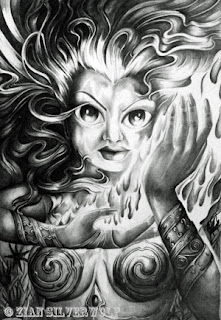 |
| I'll Be Your Apocalypse |
People have become so inundated with imagery these days that a certain level of expectation and familiarity with popular styles has become part of the appreciation of art. Most fantasy art is seen as being a realistic approach to a fantastic subject - Boris Vallejo is well-known for his real-to-life approach of the subject to make the fantastic seem possible. Brilliant stuff, he's definitely one of my heroes - but emulating what a hero does is nothing but imitation, and I have always preferred to be my own artist.
Another expectation of fantasy art is the medium - people recognize paintings and digital artworks as being the 'norm' and therefore valued art - however, this is indeed the norm for commercial, illustrative and conceptual artists; consider the ethereal, two-dimensional qualities of Botticelli's 'The Advent of Spring" - while the image is now as familiar as the Mona Lisa, it is not a work of realism, of photo-realistic technique, it carries the strong detailed qualities of classical fantasy artwork and the subject is one of pagan and otherworldly content - but it is a work of art, not a book cover, a concept design or an illustration. Botticelli's work is distinctly his own, and cannot be confused with another artist.
Many times people confuse what I do with what is achievable with technology. A completed drawing is just that - complete. It cannot be changed, rearranged or redesigned because there's no way to remove the graphite from the paper, and redraw the work. The only way it can be changed is to throw it away and start all over again. The original work is not digital, cannot be changed the way a photo or a digital drawing can be changed. It's handmade, and it is what it is. Having said that, it should also be understood that it looks the way it does because I want it to look like that.
I worked my way out of realism, because I was bored by it. My fascination with life in other dimensional states, other states of consciousness, other states of imagination needed more than just pictures of unicorns and devils, trees standing by water and small stone bridges crossing waterfalls - as much as I found them interesting, drawing and painting them realistically was duller than blueprints.
 |
| Beautiful Mine - Apparatus Series |
Japanese and Chinese artworks decorated my parent's home when I was a child - I grew up surrounded by images in the traditional style, soapstone carvings of the Buddha, or geishas wandering through orchards on stone bridges, wood carvings of dugong and pictures of Chinese landscapes inlaid with pearl. The manga cartoons of Astro Boy, Battle of the Planets, and Kimba the White Lion filled our Saturday mornings, and the tribal paintings of the Torres Straits and New Guinea filled bookshelves that lined our living room walls.
Flat, single-coloured images with fine lines, like the wood block prints of the east; round, hand-carved stone and wood, made to breathe in the figures they created. Two-dimensional paintings and three-dimensional sculptures, all with stories behind them, a long ancient cultural history, all with a life of their own.
I wanted to make my art in THAT image. It's about as autobiographical as I get, more in my technique than in the subjects I choose. Blending both concepts into one style couldn't be more signature in my mind, because this is the world I came from. I begin with real concepts and relate them fantastically.
This is where I end, and the art begins.
Related links:
I'll Be Your Apocalypse on Red Bubble
Beautiful Mine - Apparatus Series on Red Bubble